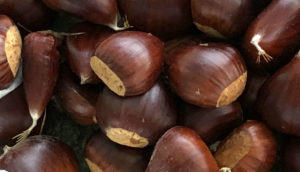During the early days of autumn, for about three weeks, chestnut trees bear their fruit. Every October walking through Laurelhurst Park, I see about a half-dozen Asian-American elders standing below the majestic chestnut trees–waiting. It never appears to be the same elders, but there are usually about 6 and never more than 10. Some come alone. Others come in twos. Each carry a plastic sack or basket to carry their bounty.

Majestic Chestnut Tree
One gentleman is framed in the sunshine with his head tilted back scanning the treetop–waiting. Two women, one my age and the other surprisingly much younger bat a wiffle ball with plastic racquets filling the time with friendly competition–waiting. Each day the chestnut foragers wander between the two clumps of about ten nut producing trees, waiting for the rewards to drop. Below each trees’ huge dripline, the lawn is littered with empty burrs, the sheath that encapsulates anywhere from one to seven chestnuts. In all the years I’ve walked the park during harvest, I had never seen anyone get a burr. I figured they must or they wouldn’t come. But, why don’t I ever see burrs falling?
Chestnut History

Harvested Chestnuts
Across the United States at the turn of the 20th century American chestnut trees were prolific. In 1904 a blight, most likely triggered by the import of an Asian chestnut variety, quickly began the demise of four billion trees. The loss of the trees was horrific, as the wood was used for everything from furniture to railroad ties and of course, the nuts for sustenance. In earlier times, chestnuts were an important food that often substituted for potatoes in the American diet. Now, it is mostly a culturally significant holiday treat roasted by a Uwajimaya grocery store vendor and sung about in a Christmas carol. There have been efforts to cross the Chinese and American chestnut to create a resilient American breed but alas, it has not happened.
Sleuthing Seattle tree databases and lore, I couldn’t find out what type of chestnut tree live in Laurelhurst Park. These trees don’t warrant the Google reference of Queen Anne Hill’s majestic rows of edible chestnut producing trees nor the University of Washington’s sorority row inedible horse chestnut tree canopy.
My Chestnut Reward

Chestnut Foraging
On my last sunny day park walk, imagine my surprise when a chestnut burr literally dropped in front of me. The bright green burr practically sparkled in the autumn sun. I grabbed it with my naked hand and was surprised by the prickly intensity of the quill-like surface. I tucked the burr gently under my arm protected by the polar fleece of my jacket, wondering what I would do with this treasure. I had no idea how to open it. Fortunately, there were still a couple elders waiting for chestnuts to drop. I showed my burr to an older woman. Her eyes glistened with excitement. I asked her how to open it. Rather than giving me verbal instructions, she put my precious burr under her foot. She squished it and rolled it back and forth until two chestnuts emerged. I held them briefly- their shiny smooth surface cradled in my hand. I had no idea what to do with two nuts! I gave them to her. She dropped them in her plastic tote. She left with a satisfied grin on her face.
Kathryn Gardow, P.E., is a local food advocate, land use expert and owner of Gardow Consulting, LLC, an organization dedicated to providing multidisciplinary solutions to building sustainable communities. Kathryn has expertise in project management, planning, farmland conservation, and civil engineering, with an emphasis on creating communities that include food production. Kathryn’s blog muses on ways to create a more sustainable world and good food!

